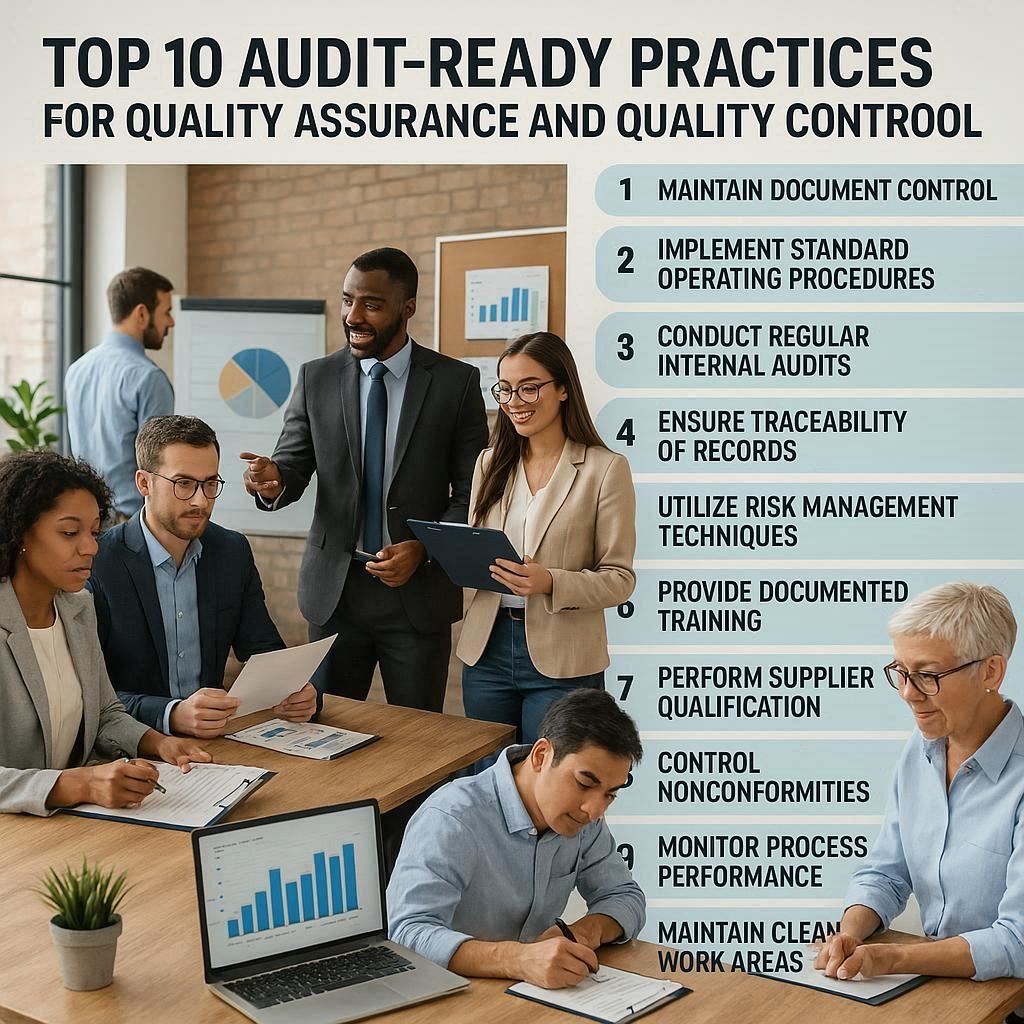Discover the top 10 audit-ready practices for QA and QC professionals in the pharmaceutical industry. Learn how ALCOA+, CAPA, change control, and document management ensure GMP compliance and inspection readiness.
Maintaining audit-ready practices demands a proactive mindset, robust quality systems, and a culture of compliance embedded across the entire organisation—not just during inspections. Success relies on the seamless integration of Quality Assurance (QA) and Quality Control (QC) functions to ensure consistent, traceable, and verifiable adherence to all regulatory and industry standards.

| No. | Audit-Ready Practice | Purpose / Key Focus | Audit Expectations | Common Pitfalls |
|---|---|---|---|---|
| 1 | ALCOA+ (Data Integrity) | Risk assessment, approval before implementation, and documentation of impact | Records must be traceable, signed, and reviewable; audit trails maintained | Ensure data is Attributable, Legible, Contemporaneous, Original, Accurate + Complete, Consistent, Enduring, and Available |
| 2 | Document Control | Maintain SOPs, protocols, and batch records in a controlled and current state | Unique IDs, revision history, controlled distribution, removal of obsolete docs | Root cause analysis, documented corrective/preventive actions, and effectiveness verification |
| 3 | Change Control | Structured process to assess and approve changes affecting quality or compliance | Implementing changes without approval, and incomplete risk evaluation | Using outdated SOPs, missing approvals, and uncontrolled copies |
| 4 | CAPA Lifecycle Management | Address deviations and prevent recurrence | Open CAPAs, poor root cause identification, and delayed closure | Timely classification, investigation, impact assessment, and documentation |
| 5 | FMEA Risk Assessment | Assess compliance with GMP and SOPs proactively | Risk ranking, mitigation measures, update after changes or CAPA | Static risk assessments, lack of justification for RPN scores |
| 6 | Training Records & Competency | Ensure personnel are qualified and trained | Maintain logs, track completion, include SOP updates, assess effectiveness | Missing records, unqualified personnel performing tasks |
| 7 | Deviation / OOS / OOT Handling | Systematically handle unexpected results | Delayed investigations, incomplete root cause, and insufficient CAPA | Repetitive observations, poor follow-up, and lack of documentation |
| 8 | Supplier Qualification / Vendor Audit | Ensure materials and services meet GMP quality standards | Risk-based audits, approved vendor list, periodic requalification | Conduct regular audits, track findings, and close CAPAs timely manner |
| 9 | Batch Record Review (BMR/BPR) | Ensure completeness and compliance before product release | Review manufacturing, QC, and deviations; verify signatures and attachments | Missing signatures, incomplete review, overlooked deviations |
| 10 | Internal Audits / Self-Inspections | Assess compliance to GMP and SOPs proactively | Assess compliance with GMP and SOPs proactively | Conduct regular audits, track findings, and close CAPAs timely manner |
| Aspect | Audit-Ready Practice |
|---|---|
| Mindset | Treat every day as a “mock audit” day — compliance should be routine, not reactive. |
| Communication | Encourage transparency between QA, QC, and production teams to address issues early. |
| Documentation | “If it’s not documented, it’s not done” — the golden rule of GMP audits. |
| Data Integrity | Review audit trails regularly; ensure electronic systems comply with 21 CFR Part 11. |
Audit readiness is not a one-time exercise — it’s a continuous quality culture.
By following these 10 audit-ready practices, QA and QC professionals can strengthen compliance, prevent data integrity breaches, and ensure successful inspections from regulatory bodies like the FDA, EMA, or WHO.
Consistent application of ALCOA+ principles, strong document control, robust CAPA systems, and well-managed supplier qualification together form the foundation of GMP excellence.
FAQs
What are the 5 C’s of audit findings?
1. Corrective Action: Steps taken to fix the identified issue.
2. Containment: Immediate actions to limit impact.
3. Cause: Root cause analysis of the deviation.
4. Communication: Informing relevant stakeholders.
5. Closure: Verification that the issue is fully resolved and documented.
1. Maintain ALCOA+ data integrity in all records.
2. Implement robust document and change control systems.
3. Ensure thorough CAPA and deviation management.
4. Conduct regular internal audits and training.
5. Perform risk assessments (e.g., FMEA) and continuous process improvement.
1. Review analytical SOPs, methods, and validation records.
2. Verify instrument calibration, maintenance, and qualification.
3. Assess sample handling, testing, and result documentation for accuracy.
4. Examine deviation, OOS/OOT handling, and data integrity compliance.
5. Conduct interviews and observation of lab practices to ensure adherence to GMP standards.
Further Reading:
Quick Links